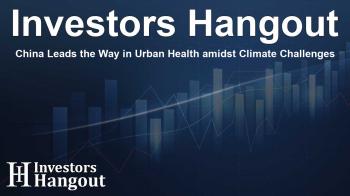China Leads the Way in Urban Health amidst Climate Challenges

China's Urban Resilience in the Face of Climate Change
A recent report sheds light on the pressing intersection of climate change and public health in urban settings across China. The Lancet Countdown China report highlights alarming trends, revealing that 8 out of 13 climate-health risk indicators have reached unprecedented highs. This crucial information, unveiled at Tsinghua University, underlines the urgent need for adaptive and sustainable urban development strategies.
Key Findings on Climate-Health Risks
One of the report's major findings indicates that Asian countries now endure an average of 20 heatwave days each year, with climate change blamed for 16 of those days. This data stresses the growing significance of climate adaptation as cities grapple with these hazardous conditions. Additionally, the issue of public risk fatigue has emerged, suggesting that ongoing climate warnings may lead to a diminished response from the public. Cities are discovering that their unique vulnerabilities are often overlooked by national averages, highlighting the necessity for tailored solutions.
Distinct City-Level Challenges
Every city is experiencing its unique climate-health challenges, as the report suggests that national assessments can mask critical local vulnerabilities. There exists a disconnect between scientific research and the pressing needs of cities, with valuable, cost-effective solutions being scarce. This indicates a strong demand for innovative approaches that prioritize public health within urban planning frameworks.
Economic Opportunities Through Health-Centered Action
Interestingly, the report asserts that health-centered climate action does not impede economic growth; instead, it acts as a catalyst for it. This perspective shifts the narrative from viewing climate action as a burdensome cost to recognizing it as an opportunity for enhanced economic resilience and growth.
Proposed Actions for Enhanced Urban Planning
The authors of the report identify five priority actions that cities must undertake to effectively tackle the climate-health crisis. These include establishing people-centered early warning systems and incorporating health-focused strategies within smart city planning. Emphasizing the need for strategic investment and targeted actions, the report serves as a call to arms for local governments to prioritize health in their climate adaptation plans.
Innovative Financing Solutions
The launch event also showcased contributions from experts across the region, focusing on practical solutions for urban health amidst climate change. New financing mechanisms were introduced, such as the Asian Infrastructure Investment Bank's emphasis on health and nature-positive infrastructure. Furthermore, the Asian Venture Philanthropy Network unveiled its Climate x Health Lighthouse Fund, which aims to support adaptation innovation across Asia through philanthropic efforts.
Moving from Planning to Action
Dr. Sandro Demaio, the Director of the WHO Asia-Pacific Centre for Environment and Health, emphasized the significance of the city-level data in the report. He remarked that it provides local governments with the insights they need to transition from theoretical planning to actionable initiatives. By equipping cities with the necessary knowledge and resources, stakeholders can better respond to specific climate-related health risks.
Frequently Asked Questions
What are the main climate-health risks identified in the report?
The report highlights severe heatwave occurrences, public risk fatigue, and unique vulnerabilities faced by individual cities.
How can cities implement proposed actions effectively?
Cities can implement proposed actions by developing early warning systems and integrating health considerations into smart urban planning.
What opportunities arise from health-centered climate action?
Health-centered climate action promotes economic growth and resilience rather than hindering it. It provides avenues for investment in sustainable urban infrastructure.
Who presented the report and what was the event's significance?
The report was presented at Tsinghua University during a celebration of World Cities Day, emphasizing collaborative urban health strategies.
How can local governments utilize the report's findings?
Local governments can leverage the report's findings to inform their climate adaptation strategies, ensuring that health is a core component of urban planning initiatives.
About The Author
Contact Caleb Price privately here. Or send an email with ATTN: Caleb Price as the subject to contact@investorshangout.com.
About Investors Hangout
Investors Hangout is a leading online stock forum for financial discussion and learning, offering a wide range of free tools and resources. It draws in traders of all levels, who exchange market knowledge, investigate trading tactics, and keep an eye on industry developments in real time. Featuring financial articles, stock message boards, quotes, charts, company profiles, and live news updates. Through cooperative learning and a wealth of informational resources, it helps users from novices creating their first portfolios to experts honing their techniques. Join Investors Hangout today: https://investorshangout.com/
The content of this article is based on factual, publicly available information and does not represent legal, financial, or investment advice. Investors Hangout does not offer financial advice, and the author is not a licensed financial advisor. Consult a qualified advisor before making any financial or investment decisions based on this article. This article should not be considered advice to purchase, sell, or hold any securities or other investments. If any of the material provided here is inaccurate, please contact us for corrections.

